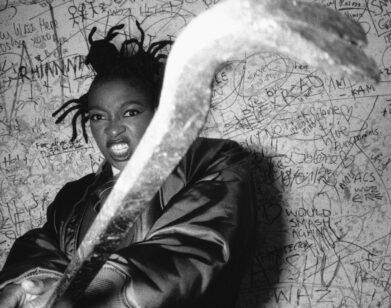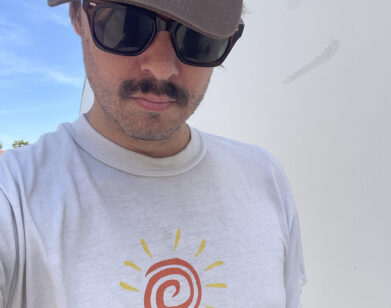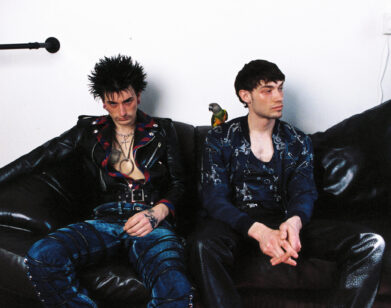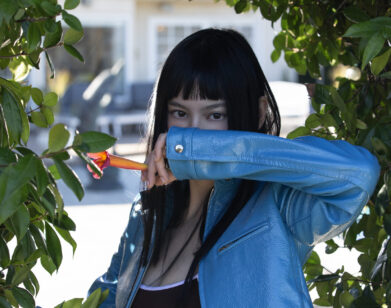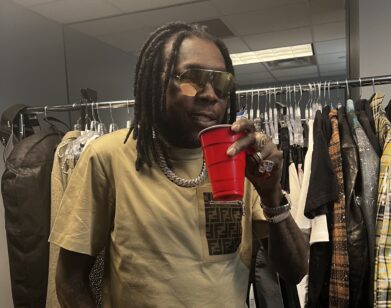Iconoclassical: Hahn-Bin, The Violin Virtuoso with a Twist
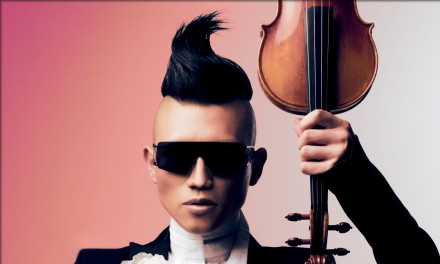
PHOTOS COURTESY OF HAHN-BIN
What would happen if you threw Rick Owens, a violin virtuoso, and a bedazzled face mask into a blender? You’d get Hahn-Bin, a Juilliard-educated protégé of legendary violinist Itzhak Perlman—and master of technique and high fashion in his own right. Hahn-Bin chases after 64th notes, zaps the audience with virtuosity, and woos with buttery tone, all while wearing black lipstick and a hairstyle as sculpted as a swirl of ice cream. The classical music world—known for tuxedos, old audiences, and expensive naps at Carnegie Hall—has never seen a talent as fierce and prodigious as Hahn-Bin, who describes himself as “the Viagra to classical music.”
On the invitation of Klaus Biesenbach, Director of PS1 in Queens and Chief Curator at Large of MoMA, during the month of March, Hahn-Bin performs in “Soliloquy: A Solo for Violin by Hahn-Bin,” a musical installation as part of the Andy Warhol: Motion Pictures exhibition. Wherever Hahn-Bin performs, audiences are rapt. “The moment I walk out on stage, the most common reaction I hear is [gasp!],” he says.
We caught Hahn-Bin after his performance at MoMA just before he disappeared into a black car. We talked about the relationship between the classical music world and the Tea Party, Juilliard, and how on earth he gets his hair to stand up like that.
MADISON MOORE: Being a classical violinist myself, I’ve been waiting on someone like you to come along forever. I’d go to concerts as a kid and wonder why Anne-Sophie Mutter got to wear ball gowns and somebody like Maxim Vengerov would come out in a tuxedo. How boring.
HAHN-BIN: Thank you so much. I really appreciate hearing that, because it hasn’t been easy. Why Anne-Sophie Mutter gets to wear these fabulous Dior gowns-that has really been a question, because Anne-Sophie Mutter is the Madonna of the classical music world. For me, she was such an important icon, because when I was younger she came to Korea to play a concert, and I was so empowered by her stance to just be a very fiercely beautiful artist. She really was Dolly Parton to a gay boy in Texas for me.
MOORE: How has the classical music world responded to you?
HAHN-BIN: Why is it that the classical music world is the Tea Party of the arts? Why is it so segregated and so confined? It’s been very interesting to see the reactions from the classical music world, because I’ve really made the transition to being a performance artist. But my language will always be classical music. What I’m hearing from the classical music industry is that the performance is not sincere, or that it’s just for show. And it’s very interesting for me to hear that, because the moment I entered first grade, my nickname became “perverted faggot.” I was seven years old, and I didn’t even know what that meant. That was a strange experience to know that from the very beginning people really had a problem with me, even though I didn’t do anything to them.
MOORE: Are you your own genre?
HAHN-BIN: At Juilliard I would be in arguments with the deans, and I would be telling them, “Why can’t I take drama classes? Why can’t I take dance classes? Because I’m interested in understanding who I am as an artist, not just what’s happening on my fingers.” And they would say, “Well, if you really are that artistic, you have to go to Cal Arts.” That’s very interesting, because when I was at a school very much like Cal Arts in California, they told me I had to go to Juilliard because I was playing too many concerts. So those are very tiny examples of understanding that I have to create the box myself. What I’m doing is to create a genre for myself, and for my own audiences.
MOORE: You studied with Itzhak Perlman for ten years. I’m sure we both grew up listening to Perlman. What was it like knowing you were studying with a legend?
HAHN-BIN: For me, it was more that he is really just one of the greatest human beings to exist. He’s the only person in classical music who I would look into his eyes, and I knew that I was okay. No matter what I went into the lesson wearing or what I had on my face.
MOORE: Was it hard for you to be yourself at Juilliard?
HAHN-BIN: I really struggled at Juilliard. I make a joke out of it. People always come to me and they’re like, “How was Juilliard?” and I always joked that my favorite part of my years at Juilliard was the shrink they assigned me.
MOORE: [laughs]
HAHN-BIN: I love everybody there, but the fact is that they really punish the individual. They really do not understand the individual. So Mr. Perlman was really an oasis in an apocalyptic environment.
MOORE: I saw you perform on the Lower East Side at The Stone a few weeks ago, and when you did “Zigeunerweisen” by Pablo de Sarasate, you whipped the bow, stomped, and sat on the piano, which made the performance even more exciting. How does the audience respond to you?
HAHN-BIN: Well, in more traditional venues the moment I walk out on stage, the most common reaction I hear is [mocks a gasp, then laughs].
MOORE: [laughs]
HAHN-BIN: Which is why I love the idea of this [MoMA] performance series, because Andy Warhol has been a pioneer in artists like myself being able to believe in what I do. And when Klaus Biesenbach mentioned this idea, I was moved to tears in the gallery, because it was like coming home. I’d been so separated from what I feel is my people, my vision, my kind of aesthetic and philosophy.
MOORE: I love how you came into the room tonight and started playing the unaccompanied Bach sonata right in front of Warhol’s Sleep. It was like two generations of art-making, facing one another.
HAHN-BIN: Absolutely.
MOORE: How would you say fashion and pop art have impacted your performance?
HAHN-BIN: My parents—everybody—would tell me that I’m a boy, I have to act this way, you can’t wear these things, you can’t put on makeup. And so for me, fashion and the visual expression of myself became a way to claim self-love. Every time I put on a lipstick, every time I drape myself, I become my own self rather than what everybody else would rather have me be.
MOORE: So you’re saying fashion and performance allows you to become—
HAHN-BIN: —true.
MOORE: True to yourself.
HAHN-BIN: But the fact is that I didn’t become this person overnight. Nobody does this overnight, and nobody does this without really struggling to find themselves. It’s interesting how many people don’t grasp the concept that fashion can be an internal experience.
MOORE: So is it hard to play octaves and double stops in Rick Owens wedges?
HAHN-BIN: Oh, it really is. Very few people understand that, Madison.
MOORE: [laughs]
HAHN-BIN: Because someone like Gaga or Beyoncé, they have their arms to create the entire choreography. I am creating choreography as much as they are, in terms of using my arms and my whole body, but the fact is that there is a reason why nobody has done this. There really is. I wasn’t wearing—because Rick hadn’t designed wedges that long ago—but I was wearing the Yves Saint Laurent Johnny boot.
MOORE: Oh, I love the Johnny boot.
HAHN-BIN: I was obsessed with those. So I would wear them every day, and I would be complaining to my friends at Juilliard that I can’t play because of these shoes. It’s a struggle, but the shoes and everything I wear is really part of the art. It’s not an option for me to take them off.
MOORE: And how on earth do you get your hair to stand up like that? It’s really fabulous.
HAHN-BIN: Magic. I was born this way.
THIS SUNDAY, HAHN-BIN WILL PREMIERE “STILL LIFE,” A NEW WORK FOR VIOLIN AND ORCHESTRA COMPOSED BY CHRISTOPHER CERRONE, AT CARNEGIE HALL. FOR MORE ON THE ARTIST, VISIT HIS WEBSITE.

